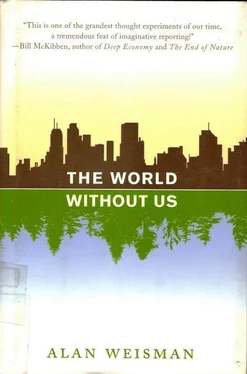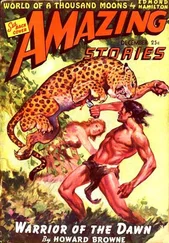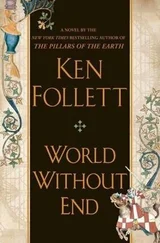From high above, the plain surrounding the park seems infected by giant spores. These are bomas: rings of mud-and-dung huts belonging to Maasai pastoralists, some occupied, some abandoned and melting back into the earth. A defensive ring of stacked, thorny acacia branches encircles each. The bright green patch in every compound’s center is where the nomadic Maasai keep cattle safe from predators at night before moving their herds and families to the next pasture.
As Maasai move out, elephants move in. Since people first brought cattle down from northern Africa after the Sahara dried, a choreography has evolved featuring elephants and livestock. After cattle chew savanna grasses down, woody shrubs invade. Soon they’re tall enough for elephants to munch, using their tusks to strip and eat bark, knocking trees over to reach their tender canopies, clearing the way for grass to return.
As a graduate student, David Western sat atop an Amboseli hill, counting cows led to graze by Maasai herders as elephants plodded in the opposite direction to browse. The census he began here of cattle, elephants, and people has never stopped during his subsequent careers as Amboseli park director, head of the Kenya Wildlife Service, and founder of the nonprofit African Conservation Centre, which works to preserve wildlife habitats by accommodating, not banning, humans who have traditionally shared them.
Dropping to 300 feet, he begins flying wide, clockwise circles, banked at a 30° angle. He tallies a ring of dung-plastered huts—one hut per wife: some wealthy Maasai have as many as 10 wives. He calculates the approximate number of inhabitants, and notes 77 cattle on his vegetation map. What looked from above like blood drops on a green plain turns out to be the Maasai herders themselves: tall, lithe, dark men in traditional red plaid shoulder cloaks—traditional, at least, since the 19th century, when Scottish missionaries distributed tartan blankets that Maasai herdsmen found both warm and light enough to carry as they followed their herds for weeks.
“The pastoralists,” Western shouts over the engine noise, “have become a surrogate migratory species. They behave much like wildebeest.” Like the wildebeest, Maasai herd their cows into short-grass savannas during wet seasons and bring them back to water holes when the rains stop. Over a year, Amboseli’s Maasai live in an average of eight settlements. Such human movement, Western is convinced, has literally landscaped Kenya and Tanzania to the benefit of wildlife.
“They graze their cattle and leave behind woodland for elephants. In time, elephants create grassland again. You get a patchy mosaic of grass, woods, and shrublands. That’s the whole reason for the savanna’s diversity. If you only had woodlands or grasslands, you would only support woodland species or grassland species.”
In 1999, Western described this to paleoecologist Paul Martin, father of the Pleistocene overkill extinction theory, while driving through southern Arizona en route to see where Clovis people finished off local mammoths 13,000 years earlier. Since that time, the American Southwest had evolved without big herbivore browsers. Martin gestured at the tangle of mesquite sprouting on public lands that ranchers leased, which they were always begging permission to burn. “Do you think this could work as elephant habitat?” he asked.
At the time, David Western laughed. But Martin persisted: How would African elephants do in this desert? Would they be able to ascend the craggy granite mountain ranges to find water? Might Asian elephants do better, since they were more closely related to mammoths?
“It’s surely better than using a bulldozer and herbicides to get rid of mesquite,” Western agreed. “Elephants would do it a lot more cheaply and simply, and they also spread manure around for grass seedlings.”
“Exactly,” said Martin, “what mammoths and mastodons did.”
“Sure,” Western replied. “Why not use an ecological surrogate species if you don’t have the original one there?” Ever since, Paul Martin has been campaigning to return elephants to North America.
Unlike Maasai, however, American ranchers aren’t nomads who regularly vacate niches for elephants to use. Increasingly, though, Maasai and their cows are also staying put. The barren, overgrazed ground ringing Amboseli National Park testifies to the result. When light-haired, fair-skinned David Western, of medium height, chats in Swahili with 7-foot, ebony Maasai herdsmen, the contrast dissolves in long-standing mutual regard. Land subdivision has long been their common foe. But with developers and immigrants from rival tribes putting up fences and staking claims, the Maasai have no choice but to seek title and cling to their lands as well. The new human-use pattern reshaping Africa may not be easily obliterated when humans are gone, says Western.
“It’s a bipolar situation. When you force elephants inside a park, and you graze cattle outside, you get two very different habitats. Inside, you lose all your trees, and it becomes grasslands. Outside, it becomes thick bushlands.”
During the 1970s and 1980s, elephants learned the hard way to stay where they’re safe. Unwittingly, they lumbered into a global collision between deepening African poverty, which in Kenya was yoked to the planet’s highest birthrate, and the boom that spawned the so-called Asian economic tigers, which unleashed a craving in the Far East for luxuries. These included ivory; the desire for it outstripped even the lust that once financed centuries of slavery.
As the price, $20 per kilo, rose by a factor of 10, ivory poachers turned places like Tsavo into a trash heap of tuskless carcasses. By the 1980s, more than half of Africa’s 1.3 million elephants were dead. Only 19,000 were left in Kenya, packed into sanctuaries such as Amboseli. International ivory bans and shoot-to-kill orders for poachers calmed but never eradicated the carnage, especially the slaughter of elephants outside parks on the pretext of defending crops or people.
The fever tree acacias that once lined Amboseli’s swamps are now gone, downed by overcrowded pachyderms. As parks become treeless plains, desert creatures like gazelles and oryx replace browsers like giraffes, kudus, and bushbuck. It is a man-made replica of extreme drought, such as Africa knew during ice ages, when habitats shriveled and creatures crammed into oases. Africa’s megafauna made it through those bottlenecks, but David Western fears what may happen to them in this one, stranded on island refuges in a sea of settlements, subdivisions, exhausted pastures, and factory farms. For thousands of years, migratory humans were their escorts across Africa: nomads and their herds taking what they needed and moving on, leaving nature even richer in their wake. But now such human migration is coming to a close. Homo sedentarian has flipped that scenario. Food now migrates to us, along with luxury goods and other consumables that never existed through most of human history.
Unlike anywhere else on Earth—save Antarctica, where people never settled—Africa alone has not suffered a major wildlife extinction. “But intensified agriculture and high human population,” Western worries, “mean that we’re looking at one now.” The balance that evolved between humans and wildlife in Africa has tipped out of control: too many people, too many cows, too many elephants stuffed into too few spaces by too many poachers. The hope that sustains David Western lies in knowing that some of Africa is still as it was, before we evolved into a keystone species potent enough to push even elephants around.
If there were no people left, he believes, Africa, which has been occupied by humans longer than any other place would paradoxically revert to the purest primeval state on Earth. With so much wildlife grazing and browsing, Africa is the only continent where exotic plants haven’t escaped suburban gardens to usurp the countryside. But Africa after people would include some key changes.
Читать дальше











